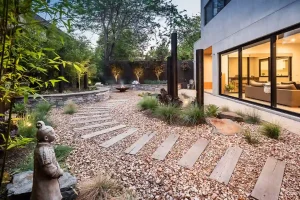Let’s transform our outdoor spaces into eco-friendly havens. Traditional landscaping practices often harm the environment, but by designing a sustainable outdoor landscape, we can create green sanctuaries that benefit us and our local ecosystems. From conserving water to choosing native plants, the journey to a greener tomorrow begins now.
Key Takeaways
- Adopt a comprehensive approach to sustainable design, integrating environmental stewardship, social responsibility, and economic viability.
- Opt for water-efficient designs, incorporating drought-tolerant plants and rainwater harvesting systems to minimize water waste.
- Choose sustainable building materials with low embodied energy, such as reclaimed wood, bamboo, and recycled plastic, to reduce carbon footprint.
- Select native plants that require minimal maintenance, support local biodiversity, and thrive in local climate conditions.
- Emphasize minimizing ecological footprint and improving quality of life for users through sustainable landscape design principles.
Understanding Sustainable Landscape Design
Three key principles underpin the concept of sustainable outdoor design: environmental stewardship, social responsibility, and economic viability, all of which are essential for designing a sustainable outdoor environment that not only minimizes its ecological footprint but also improves the quality of life for its users. By integrating these principles, designing a sustainable outdoor environment becomes a comprehensive approach that benefits both people and the planet.
Water Conservation in Landscaping
Regularly, garden architects and homeowners alike are opting for water-efficient designs that not only reduce their environmental footprint but also lower their water bills. When designing a sustainable outdoor scenery, consider incorporating drought-tolerant plants, rainwater harvesting systems, and irrigation controllers to minimize water waste and conserve this precious resource.
Choosing Sustainable Building Materials
Furthermore, thoughtful water management, and designing a sustainable outdoor environment requires careful consideration of the building materials used, as the environmental impact of these materials can significantly affect the overall eco-friendliness of the outdoor space. Opt for materials with low embodied energy, such as reclaimed wood, bamboo, or recycled plastic, to minimize the carbon footprint of your outdoor setting.
Native Plants for a Greener Tomorrow
Incorporating native plants into your outdoor design is a crucial step in designing a sustainable outdoor environment, as they require less maintenance, support local biodiversity, and create a unique sense of place. When selecting native plants, consider:
- Plants that thrive in local climate conditions
- Species that support local pollinators and wildlife
- Plants that require minimal watering and maintenance

Frequently Asked Questions
How Do I Balance Aesthetics and Sustainability in My Outdoor Space?
To balance aesthetics and sustainability, incorporate native plants, water-efficient features, and eco-friendly materials into your outdoor design, ensuring a visually appealing space that minimizes environmental impact as well.
Can I Still Have a Lush Lawn With Sustainable Landscaping?
While sustainable landscaping often prioritizes low-maintenance, drought-tolerant alternatives, it’s possible to achieve a lush lawn while minimizing environmental impact by selecting indigenous grass species, implementing efficient irrigation systems, and adopting eco-friendly maintenance practices.
What Are Some Low-Maintenance Options for Sustainable Landscaping?
For low-maintenance sustainable landscaping, consider incorporating drought-resistant plants, succulents, and groundcovers, which require minimal watering and care, reducing the need for fertilizers, pesticides, and excessive pruning.
Can I Incorporate Existing Hardscapes Into My Sustainable Design?
When incorporating existing hardscapes into your sustainable design, consider repurposing or refurbishing existing structures to reduce waste and conserve resources, ensuring a harmonious blend of antiquated and fresh elements.
How Do I Measure the Environmental Impact of My Landscaping Choices?
To measure the environmental impact of landscaping choices, consider using eco-metrics such as carbon footprint, water usage, and biodiversity indices to quantify and alleviate the ecological effects of your outdoor space design decisions.
Conclusion
In summary, the implementation of sustainable landscaping practices is essential for mitigating ecological degradation. By integrating water conservation, sustainable building materials, and native plant species, outdoor spaces can be transformed into eco-friendly havens. This comprehensive approach not only reduces environmental impact but also nurtures a harmonious relationship between human populations and the natural world. As the importance of environmental stewardship continues to grow, sustainable landscape design will play a vital role in shaping a greener, more resilient future.
You May Also Like: